Combat
Combat at its core is very simple. After all elements have moved, any elements that are in range and pointing at an enemy element gets to fire. To fire with fixed front guns some part the target element must line up within the side edges of the firing plane extended. Some planes have tail guns, and some even have side gunners. Those are flexible guns and they have a firing arc.
Hits, Damage and Max Damage Per Attack
This is one of the elements of Table Air Combat that I love. The performance rulers indicate how many dice each element fires when attacking. Elements roll that many D6 and compared the results to the target’s defense. Each roll that equals or exceeds the defense total is a hit. For each hit scored the attacker roles another die and compared the results to the defender’s airframe. Some planes take more damage than others. Likewise, some guns do more damage than others. Each plane types has a firepower rating. When rolling for damage, that number is added to each die.
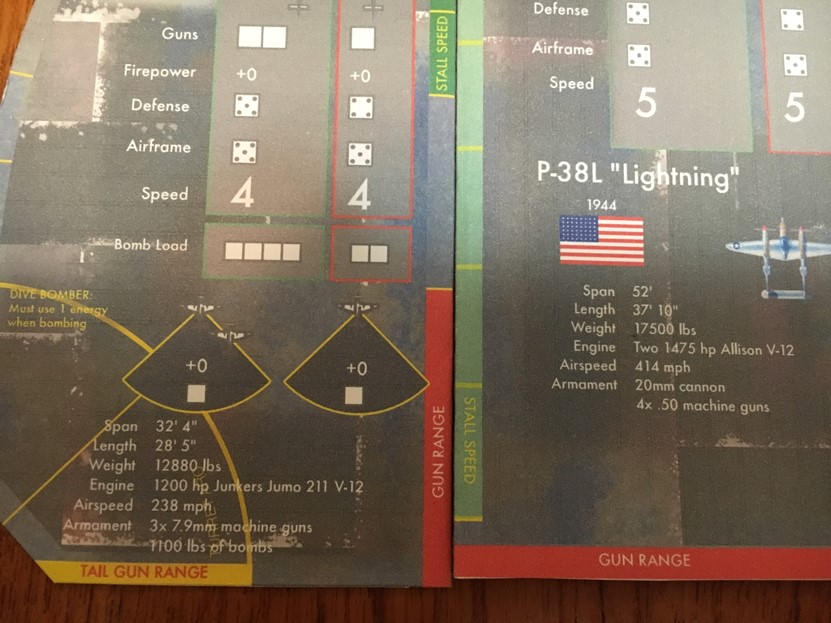
Here you see vital stats for each planned type (another thing I love about this game). The Stuka has three 7.9mm (about .30 caliber) machine guns, but one of them is in the trail. The P-38 Lightning has a powerful 20mm cannon and four big .50 caliber machine guns, all nose mounted.
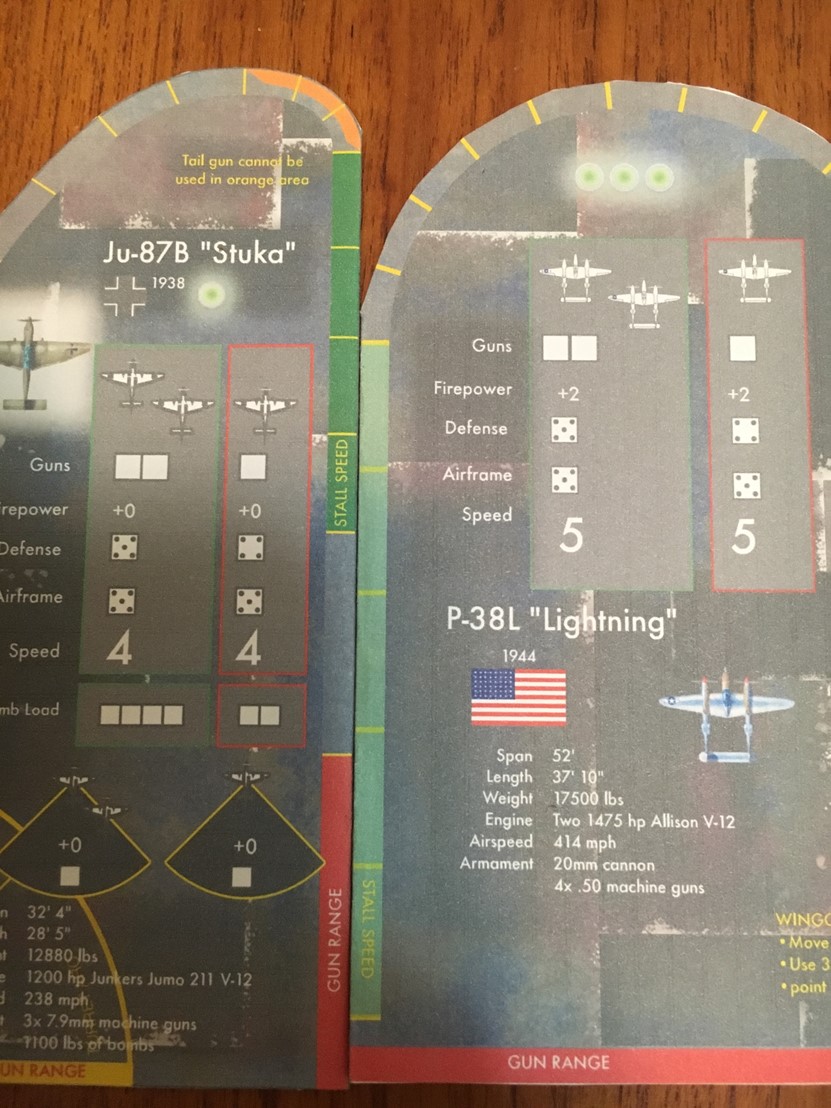
Here you see that both planes fire the same number of dice, but the Lightning had a +2 modifier when checking to see if it’s hits did damage. Note that both planes have the same defender and airframe ratings.
In this combat, the Stuka stacked beneath the lead P-38 fired and scored 1 hit, but rolled a 4 for damage, doing none. The Stuka tail gunner scored a hit with one die AND rolled a 5 for damage, so the lead P-38 element is reduced.
The P-38 cut loose at point blank range (no effect for near or far shots in the game, you either have the short or you don’t). It b scored 2 hits AND both hits did damage (a 6 and a 4, both of which receive the +2 firepower modification). HOWEVER, a single attack, no matter how many hits and damage it secured, can not destroy a full strength element. So the Stuka is reduced. If both Stukas that fired on the P-38 had done damage, it would have been destroyed, as those C are separate attacks. Note on the performance rulers that reduced elements roll fewer dice (there are half the number of planes) and have a lower defense value (there is no wingman).
Targeted by multiple sources
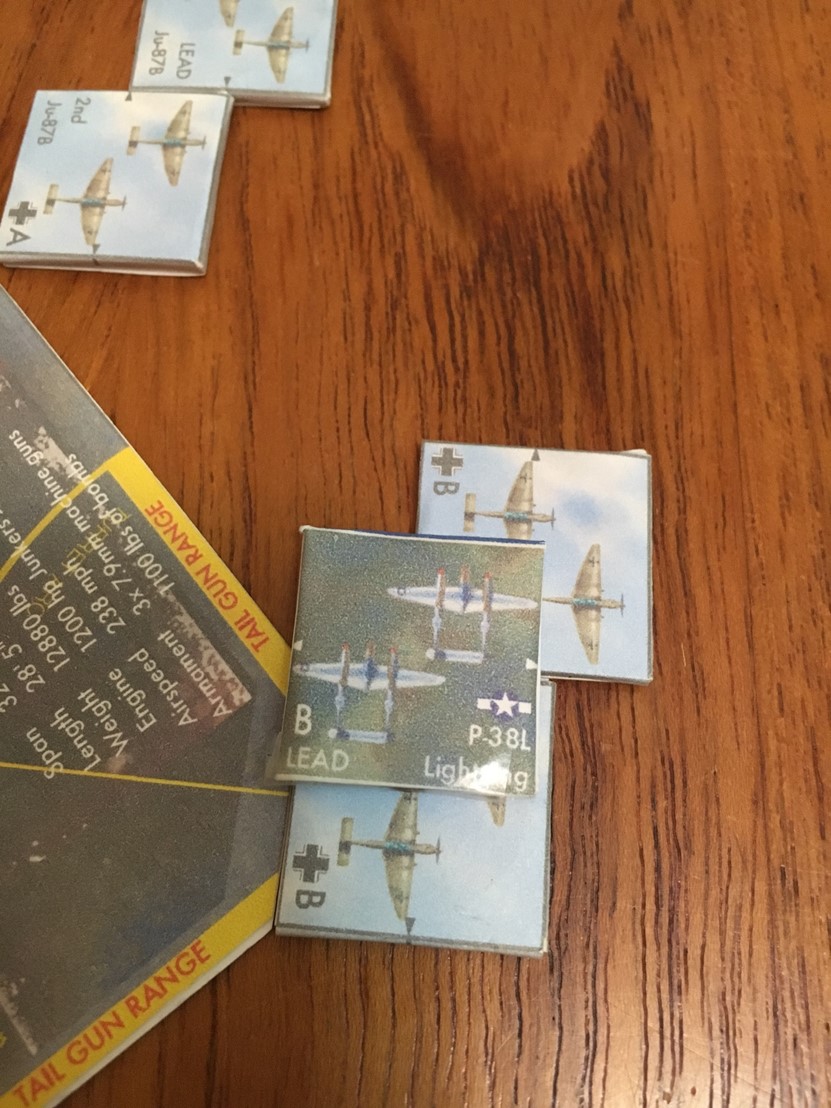
Note that this P-38 can be fired at by both tail gunners, since the edge of the counter overlaps the trailing Stuka’s gun arc. A smarter play might have been to move so that only the trailing German plane had a front gun shot. Same number of dice, but only one potential damage. Note on that later. The trailing Style is just out of range.
All shots once again miss.
Bombing Runs
Table Air Combat has dive bombers (the German Stuka and the US Dauntless), medium level bombers (German He-111), torpedo bombers that can also carry iron bombs (US TBF-1C Avenger, Japanese G4M Betty) and so far one heavy bomber (US B-17F Flying Fortress). Those bombers can attack land targets or naval targets. Those targets have AAA defenses, flak for ground targets and both flak and close in AAA guns for ships. Each target type has a hit number and a number of circles representing the number of hits required to destroy it. Some targets need two rolls of 6, some four rolls of 4, some three rolls of 5… you get the idea. In the picture of the Stuka’s performance ruler you saw an indication for “bombs.” When the plane makes a bombing run it rolls that number of dice. Any rolls equal to or above the hit number is a hit.
Fighters can strafe ground targets also, but doing permanent damage that way is hard unless the plane in question has the ability to fire The Whole Nine Yards. Think P-47D, I’ll leave the rest for you to figure out.
Here is a photo of a bombing run from a different AAR, Surprise Attack.
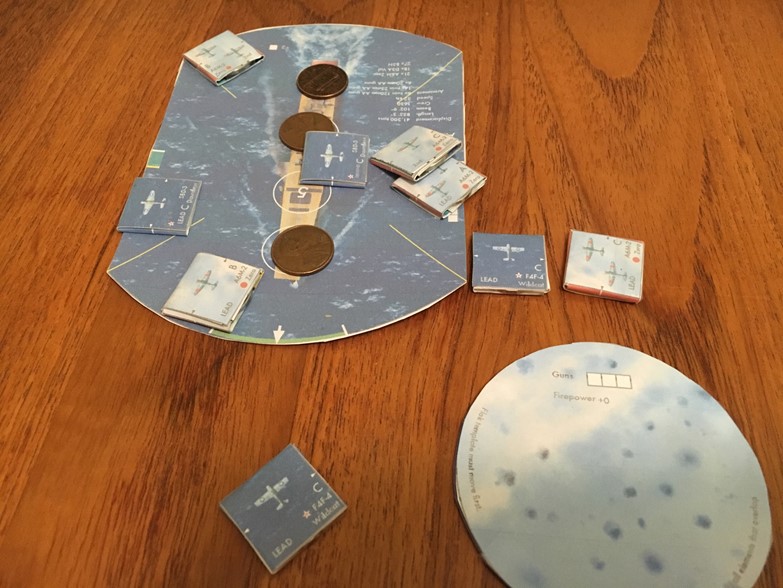
That is how the game works, probably in more detail than a game review needs. Still, I wanted to show how what is a simple and inexpensive game can offer a lot of interesting game play without an exorbitant number of components or very heavy rules.
PROS
Clearly I love this game, so I think virtually everything I’ve written is a pro. Here are what I find to be the most compelling elements:
- Simple rules
- Fast, fun gameplay
- Lots of variety in planes and sceanrios
- Inexpensive & easy to assemble
- Portable, fast setup and breakdown
CONS
Personally I find very little lacking here. I know that some folks who are actual fighter pilots or more experienced tabletop / computer flight sim players will find that the game lacks some important details related to realism. I’m not very experienced or good at that so I don’t know what I’m missing, if I’m missing anything. [thread=1596550]If I get better at it[/thread] and decide the game has a problem there I’ll update this review. I heard one person say he wished the plane graphics were a single strip, rather than a T shape, for easier cut-out and assembly. I will say I’d find it easier and faster to assemble the game that way, although the quality might suffer. I’ll weigh in and say my preference would be a strip as the final quality of the elements isn’t important enough that it would make a difference. That is a super minor quibble though, as I see it. I think you could make the point that some of the planes are so similar in performance characteristics that having each of them isn’t necessary (the multiple Bf-109 models are really the only place that applies though). And again, that is a minor point. It’s OK not to buy every plane that’s available. Well, it’s OK for some people. If anything that last point only speaks to how hopeful I am about new releases in the series. When I first discovered this game it seemed that the designer primarily supported it through his Facebook page, and since I’m not on FB that was a bummer. But he has been on the forums here answering questions a lot, so I don’t see that as a con.
Brass tacks time – for me there are no real cons to this game.
FINAL THOUGHTS
What more can I say? I hope some of you buy a couple of plane types (or more), build them and put them on the table. I’d love to see more reviews or AAR’s show up here on BGG (I don’t think there’s an entry for it on CSW yet), and to get some more folks giving it a go.
Here is a photo of my completed collection, which was rendered incomplete by the welcome addition of the G4M Betty a few days back. I’ll update the photo when I can. I hope that it is made out of date quite often.
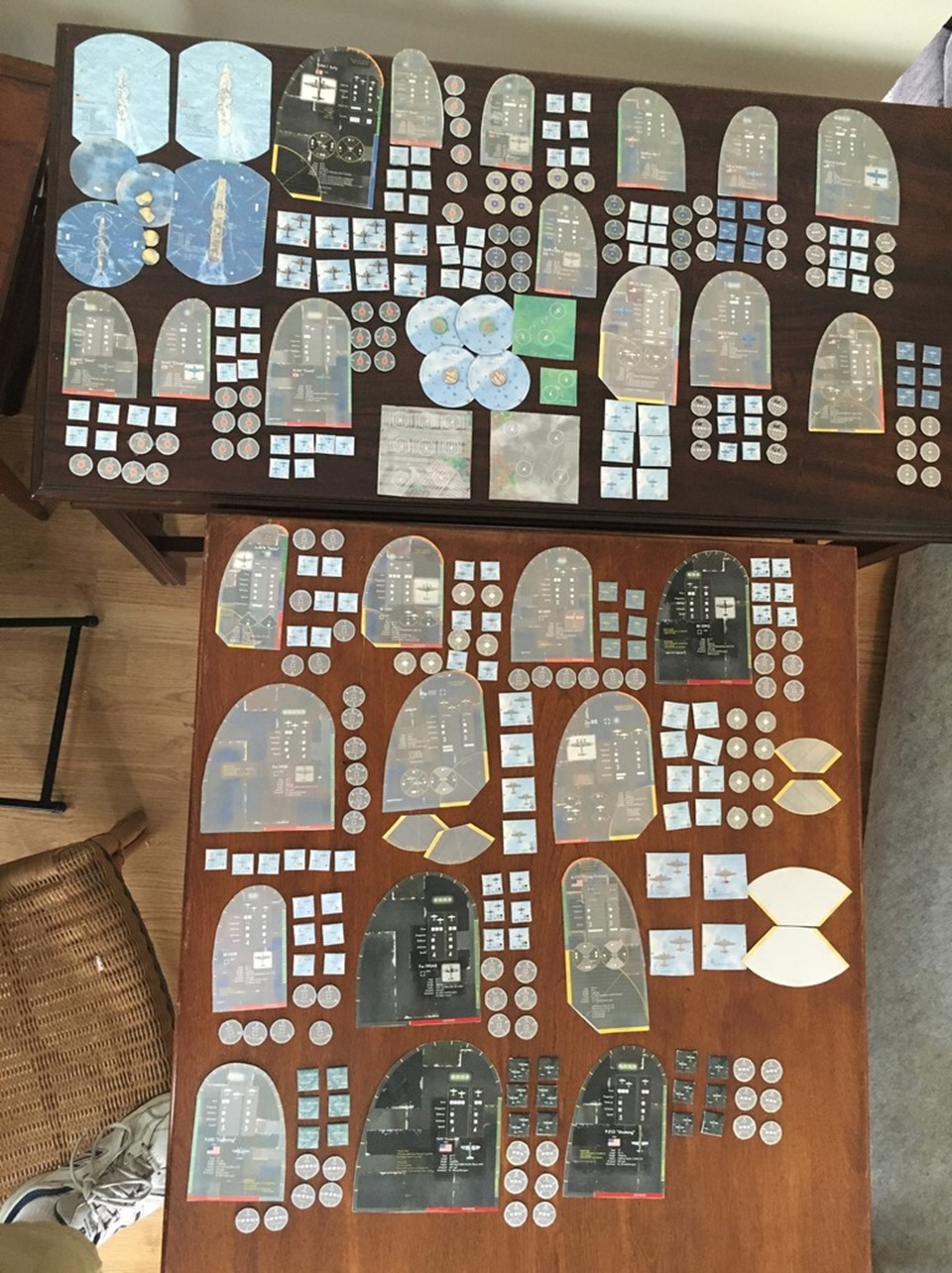
Whoever wrote this article is clearly a brilliant and sophisticated human being, not to mention a dashing and handsome fellow.
I also like how TAC takes a complex idea (aircraft performance) and turns it into something fairly fairly straightforward. If there is one thing I would like to see it would be the introduction of phased movement…like in the advanced version rules of Flight Leader or perhaps more popularly…Car Wars. I never really like the IGOUGO mechanism for flight combat games as I feel like my aircraft are kind of just “hanging” in the air waiting for my opponent response.
That sounds interesting, but probably outside the scope of this game. The advanced rules for tracking speed are a nice addition, but I wouldn’t want much more complexity than that.